
- HOME
- ABOUT
- ARTISTS
A.P.A.T.T. APOSTILLE BAMBOO BARR BERTIE MARSHALL BIRD NAMES BRONTEZ PURNELL BUFFET LUNCH CHESTER ENDERSBY GWAZDA CHOPS CLEAR HISTORY CLECKHUDDERSFAX COLD PUMAS CONSTANT MONGREL DARLENE SHRUGG DEATH SENTENCE: PANDA! DEERHOOF DOG CHOCOLATE DRUM EYES EARTH BALL ED SCHRADER'S MUSIC BEAT ES ESQUILAX FEATURE FOOT VILLAGE FORMER GHOSTS FUTURE ISLANDS GAY AGAINST YOU GARY WAR / PURPLE PILGRIMS GEN POP GENTLE FRIENDLY GOWNS THE GREEN CHILD GUTTERSNIPE HALO HALO HANDLE HANDS ON HEADS HASH REDACTOR HELHESTEN HIGH PLACES HISTORICALLY FUCKED HYGIENE KAPUTT KIT LEOPARD LEG LINDA SMITH / THE SMASHING TIMES LUCKY DRAGONS LUNCH LADY MARCEL WAVE JOHN MAUS ME LOST ME MUNCH MUNCH NAKED ROOMMATE NICFIT NO AGE NO BABIES NORMIL HAWAIIANS NOTS NUMBERS PARSNIP PEEPHOLES PEGA MONSTRO THE PHEROMOANS PHILIP FROBOS PIKACYU-MAKOTO PLEASE PLUG PRIMO! QUINIE RAT COLUMNS RATTLE RAVIOLI ME AWAY RED CHANNEL ROBERT SOTELO ROBERT SOTELO & MARY CURRIE SAUNA YOUTH SCREENSAVER SHAKE CHAIN SILVER FOX SCHOOL DAMAGE SOFTBOILED EGGIES SOILED MATTRESS & THE SPRINGS SLEEPER AND SNAKE SPIN SPIN THE DOGS SPRAY PAINT THE STICKS TERRY T.I.T.S THE TOADS TRASH KIT TRENCHER VEXX VINTAGE CROP VITAL IDLES WAY THROUGH WATER MACHINE WETDOG THE WHARVES THE WORLD XIU XIU XIU XIU / PARENTHETICAL GIRLS YIKES
- BLOG
- LINKS
- SHOP
- TOURS
- TICKETS
PHOTOS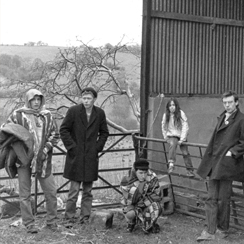
|
HI RES DOWNLOADS |















|
ABOUT NORMIL HAWAIIANS |
NORMIL HAWAIIANS had a transformative 1982. With two 7" singles and a 12" EP under their belts they suddenly found themselves disillusioned with the increasingly generic sounds surrounding them, so they forced the hand of change and began reaching out with that very hand. The band's true constant in Guy Smith soon found himself with a new crew of musicians, Simon Marchant, Noel Blanden and Mark Tyler. Normil Hawaiians' communal take on post punk quickly sprouted leaves from its mouth, and began carving out a new furrow. Greater emphasis was awarded to improvisation within the group and as a result their songs embarked on longer, freer journeys towards the beaten bounds. They wanted these new songs to bear the weight of their new collective spirit so comfort zones had to be left behind. Tape loops, echo boxes, extended percussive sessions and duteous faith in the tones emanating from a particular old wah-wah pedal were all employed by Normil Hawaiians to stretch their sonic fabric into wild and redolent new dimensions. With Illuminated Records interested in the band's new visionary approach, Normil Hawaiians relocated from their South London dystopia to a rural idyll in the Welsh hills, determined to develop further this raw language for themselves. They booked into Foel Studios near Llanfair Caereinion for an extended period of time, set the tapes rolling and didn't look back. They were somewhere they knew they could experiment; at a studio that understood the results would be uncertain. Dave Anderson, who managed and engineered at Foel was exactly the right person to work with them. Anderson had come from an experimental background himself, having played in Hawkwind and Amon Duul II. Normil Hawaiians were encouraged to explore their ideas beyond limitations with Anderson happy to leave the tape recording to capture their embryonic improvisations taking shape. Anderson even joined in on bass for several of those sessions as the ensemble strove to find its authentic voice, supplemented further when their cellist friend Klaus dropped by to spend a spell with them. At this very moment Normil Hawaiians existed solely for the music, living together in a small cottage in the studio's shadow, sharing everything together and working long days to nurture and then burnish the music they had discovered between them. This is how the band's debut album 'More Wealth Than Money' was formed, through trial and close listening, through cultivation and patient growth. Of course there were significant amounts of mushrooms involved too and several UFO sightings, but when the sheep began to march in time to the music Normil Hawaiians knew they were creating something unique. |
NORMIL HAWAIIANS RELEASES |
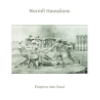
EMPIRES INTO SAND
ExilesUTR163 | LP/ CD | 9 tracks, 45 mins | Buy
'Empires into Sand' is the first album of new material from Normil Hawaiians in 40 years. The group first refined their sound during the early 80s, hitting on a pastoral experimentalism that drew on ambient drone, motorik impulse and post-punk pep. 'Empires into Sand' came together in the familiar manner of their original three albums, with improvisation and nuance informing the blueprint of the tracks. It was with the official release of this last record 'Return of the Ranters' (originally recorded in 1984/85, but then unconsciously shelved) in 2015 by Upset The Rhythm that led to the group reconnecting with the intention of playing music together again. Normil Hawaiians played a launch show for that 'lost album' and followed that up with more concerts, including an appearance at Supernormal, a residency at the Edinburgh Festival, gigs at Cafe OTO. They were even chosen by Richard Dawson to perform with him in London. Throughout this time, Normil Hawaiians revisited their original songs for live performance. However for a group always so interested in evolving their sound, it came as no surprise that they shirked at the idea of a faithful retread. The band pushed their songs into new inventive dimensions, still progressive at core, but now imbued with a cosmic uncanny. A cinematic approach that was always quietly present has come to the fore. The quaint weirdness of folk song, the humanity of communal practice and the group's ecological mindedness have all found a place in Normil Hawaiians' current sound world. When Normil Hawaiians write and record music they prefer to gather in a remote location and live together for a while, such is their communal ethos. Being far-flung across the UK, the Family Hawaii (numbering seven key members) decided to encamp to Tayinloan, a small village on the west coast of the Kintyre peninsula in Scotland. They set up their own studio in an isolated, windswept house overlooking the sea and started the tape rolling. Noel Blanden from the band explains the process neatly: "we set up and began playing, slowly and patiently, allowing the music to take its own shape based on where we were staying and our ongoing friendship. We recorded for days, capturing everything. A lot of new and rich ideas began to emerge". Normil Hawaiians took their time to develop these threads at their own pace, allowing songs to mutate and settle over months. Simon Marchant deftly produced and recorded the album whilst also performing in the band, this marked the first time the band had total control of their own sound. The last few years has seen the band reconvene in Herne Bay, Faversham, London and Leith to record new parts, constantly responding to the changing form of these quietly spectral songs of defiance. 'Empires into Sand' incorporates samples from old rehearsals and live music into the new finished pieces, this is in continuum with their previous records. Snippets of sound from the static of short wave radio and satellite transmissions also embellish the work. In fact the whole album is stitched together with interludes, creating a acutely immersive 45 minutes. 'Exiles' opens the album amid swirling atmospheres, synth flights and recordings of Vilnis Egle (father of Zinta Egle from the band) retelling his experience of fleeing his home in Latvia during Soviet occupation in 1942. George Bikandy also features on this track talking about his flight from Syria in 2014. 'Ghosts of Ballochroy' is a winding river of a song featuring a lively discourse in Scots courtesy of Rodney Relax. There's a commitment to truth telling present across this hopeful album populated with angels, incoming tides, long shadows and the rose-washed sun. "From our broken windscreen, we feel the breeze" soars Guy Smith triumphantly over the driving beat of 'Waterfalls : Bedford 330'. 'Big City Sky' flutters and sparkles with rapid synth runs, tape-looped drums and Jimmy Miller's commanding vocal. With 'In The Stone' Zinta's melody is deliberately jagged and blunt, exaggerated by octave-layered vocals and interjections from Guy. This is thought-provoking, boundary-bothering music. Honest in intent, a solidarity of vision. The album's title is derived from a poem by band member Mark Tyler, who sadly passed away during the recording process and the transience of life is felt heavily throughout. Noel best coins the group's wish for the album: "we wanted to create an album that acknowledges our history and also reflects who we are today. We remained true to ourselves and we wanted to make something beautiful without removing the edges." 'Empires into Sand' certainly does that, it's an echo from the past, an echo from the future. 'Empires into Sand' by Normil Hawaiians will be released on LP/CD/digital on May 3rd by Upset The Rhythm.
|
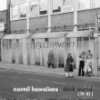
DARK WORLD
Still ObedientUTR130 | LP/ CD | 22 tracks, 67 mins | Buy
'Dark World' collects together choice material from Normil Hawaiians' formative early years of 1979-1981. Tagging along with the band from their peppy post-punk origins (so brilliantly debuted on 'The Beat Goes On') into the looser, dubbier territories that laid the foundations for the group's landmark album 'More Wealth Than Money'. 'Dark World' gathers the group's energetic 7" singles on Dining Out and Illuminated Records, their metamorphic 'Gala Failed' EP (Red Rhino) and a lively last-minute Peel session from 1980, alongside outtakes, rarities and demos. During this feverish time, founding member Guy Smith was motivated to make music that reveled in always trying out different things. Normil Hawaiians was a very fluid ensemble at this point, Guy often accompanied by Kev Armstrong and Jim Lusted encouraged saxophones, violins, synths, pianos and a select pack of female backing singers to take their post-punk sound into wilder directions. One of the earliest line-ups of Normil Hawaiians featured a 15-year old Janet Armstrong on vocals alongside Guy, 'Ventilation' best showcases her deadpan digressions. Janet went on to sing alongside David Bowie a few years later on his breathtaking mid-80's gem 'Absolute Beginners'. By this point Kev Armstrong was also guesting for Bowie on guitar duties too. Another guest to join the ranks of Normil Hawaiians during this fertile time of cross-pollination was Bertie Marshall (aka Berlin of the proto-punk Bromley Contingent). 'Sang Sang' is a good example of how he was inspired to deliver his poetic treatise over the band's atmospheric, floating improvisations. Bertie's impressionistic influence helped the group uncouple further from rock tropes, as they became restless and more rhythmically-focused. 'Still Obedient' fidgets, soars and careens across the dancefloor, "if you're ahead close your eyes, you won't notice the subtitles" chants Guy. By the end of this transformative two years Normil Hawaiians had spun an exceptional chrysalis around themselves. The dark world surrounding wouldn't win out, they'd eaten-up the music and grown continuously, wrote and recorded rapidly, covered Zappa & even David Lynch and could feel the light beginning to shine through. 'Dark World' is a snapshot of a band in flux, finding their feet, stretching their limbs. Normil Hawaiians cover an awful amount of ground in such a short time-frame on this record and these tracks document all the glittering debris from their magpie's nest. Emergent, hopeful and resistant in sound and ethic.
|
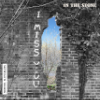
IN THE STONE 7"
In The StoneUTR134 | 7" | 2 tracks, 6 mins | Buy
When Upset The Rhythm released Normil Hawaiians' lost album 'Return Of The Ranters' back in 2015, the band members got back in touch with each other after a 30 year break and starting playing music together again. Out of this the group played a launch show for the album and followed that up with more concerts, including an appearance at Supernormal, a residency at the Edinburgh Festival, gigs at Cafe OTO and supporting Richard Dawson in London too. They even recently toured Greece in support of having all three of their renowned exploratory post-punk albums finally back in print. Throughout this time, Normil Hawaiians revisited their original songs for these live performances. However for a group always so interested in evolving their sound and seeking nuance, it comes as no surprise that they shirked the idea of a faithful retread of old material in favour of reimagining their songs. The group experimented by pushing their songs into new inventive dimensions, still progressive at heart, but now imbued with a cosmic uncanny. A cinematic, even pastoral approach that was always quietly present has come to the fore. The quaint weirdness of folk song, the humanity of communal practice and the group's ecological mindedness have all found a place in Normil Hawaiians' current sound world. With this conducive atmosphere brewing, the band's first new songs in decades started to emerge. Being far-flung across the UK, the Family Hawaii encamped to Tayinloan, a small village on the west coast of the Kintyre peninsula in Scotland with the intention of recording new music. They set up their own studio in an isolated, windswept house overlooking the sea and started the tape rolling. Noel Blanden from the band explains how the spirit of the location was such an inspiration to the group during this initial recording session: "Our time immersed in the place and the unique energy it generated in us allowed us to write 'In The Stone'. It goes right back to our first album, this need to document experience before it passes over and eludes us. We were grabbing at the musical ether and letting it shape itself through the band." From loose, improvised sessions and reflective periods of listening in Tayinloan, Normil Hawaiians captured the moment. 'In The Stone' is a motorik thrill of distorted guitars, locked rhythms and morphic resonance. Guy Smith is joined by Zinta Egle on vocals, skilfully sharing lyrics informed by Alan Garner and Nigel Kneale's ideas around recurring events being linked to place and historical artefact; a kind of residual haunting known as 'Stone Tape' theory. In keeping with the context of the song, sounds from several previous live recordings of the track were woven into its present being. Flipside 'Where is Living?' is a decidedly more delicate affair of questioning lyrics and eerie traces, droning strings and impressions smudged. This resultant 7" is a tantalising glimpse of Normil Hawaiians now, an echo from the past, an echo from the future.
|
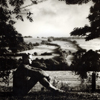
WHAT'S GOING ON?
Market PlaceUTR121 | CD / LP | 17 tracks (7 bonus tracks) 76 mins | Buy
Following the release of More Wealth Than Money (Illuminated, 1982), there was an impetus to make good on hard won achievements. Rehearsal and writing sessions resumed in the early months of 1983 at Intergalactic Arts Studios, off the Old Kent Rd in London. IGA was a ramshackle, semi-residential rehearsal space where the Hawaiians - none of them 'natural' musicians - would often play and rehearse in the dark, recording demos onto cassette. Illuminated Records had been sending roster artists to Foel Studios in Powys, Wales for years, and it had become a kind of refuge for the Hawaiians. As Guy Smith says of that summer "Canary Wharf had been built. The squat scene was closing down. We had to get out. We got in the bus and hit the road." Studio owner/manager (and Hawkwind/Amon Duul II alumnus) Dave Anderson was welcoming, unruffled and accommodating when around a dozen band members, friends and family emerged from the 'mini-peace convoy' of vehicles into the hazy, pastoral care of the warm, Welsh countryside. Although Foel was and is a residential studio, the very number of people who showed up meant some were kipping down where they could, sleeping in vans and cars for two weeks. Mixed tapes were then taken by Dave Andersen and Guy Smith to Charly Records' editing studio in London where Andersen had worked and was able to pull downtime. Here they spliced the recordings into an irregular yet coherent, flowing work, Side One being intentionally and meticulously honed as a seamless and inventive narrative. Recalling the rudimentary nature of both the equipment and the demo tapes brought in, Snelling now views the end result as 'brilliant' though his initial feeling on hearing the edited and mastered LP was that the record had been 'cut to pieces'. Final masters were then EQ'd and cut by Graeme Durham at the newly opened Exchange Mastering Studios in Camden. And then nothing happened. Unbeknownst to the band, Illuminated Records were getting into deep financial problems and by early 1984 were struggling to release label-saving albums from Throbbing Gristle, 400 Blows and Kevin Ayers. Meetings with company boss Keith Bagley were often held in dusty old daytime drinking clubs around the Fulham Road, but the label was in its death throes. Test pressings sounded good but the printing of the cover was all wrong. The cover image was too green, though thankfully a final batch had this corrected to a more appropriate sepia hue. As it became clear that the release was in danger of a catastrophic failure without the goodwill of distributors and promotors, the label gave the band 250 copies to sell as a 'Sorry for Messing Up goodbye present', but the record shops wouldn't touch them. The company had been blacklisted. Smith and Alun 'Wilf' Williams screen printed the label name off the LP to distance it from disaster, but to little avail. This intricate, challenging and engaging work had been failed by poor circumstance. Upset The Rhythm released the re-mastered version of 'What's Going On?', accompanied by copious liner notes, photographs and seven bonus tracks in the summer of 2019.
|
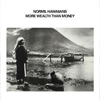
MORE WEALTH THAN MONEY
British WarmUTR096 | 2xCD / DLP | 13 tracks (12 bonus tracks) 155 mins | Buy
'More Wealth Than Money' proved a vastly ambitious debut album, sprawling across four sides of vinyl in a way that still feels truly expansive, brave, cinematic even. From the plaintive pastoralism of 'British Warm' to the transcendental vistas of 'Other Ways Of Knowing', the album constantly surprises with its ringing trails of guitar, motorik pulse and synth rambles. From the striving incursion of 'Sally IV' to the softly spoken disbelief of 'Yellow Rain' the album is nothing short of a waking dream. Guy Smith's vocal floats through the album in a haunting manner, at times heartfelt at others overcome. He's on a quest to his own celestial city and we can stay for the whole journey if we only listen. Described by the press upon its release in 1982 as an "absolutely mesmerising double album travelling through progressive rock, via industrial folk to freaky art-punk whilst sounding delightfully coherent" and "a huge slab of mindblowing dark psychedelia" the album was critically acknowledged for its peculiarly British kosmische. However for an album so indebted to the fertile soil from which it sprang, it's curious that 'More Wealth Than Money' never came out officially in the UK. The band's label Illuminated were temporarily blacklisted by their distributor because of unpaid debts and so the album was only available from the band at concerts within the UK. The bulk of the record's sales went to mainland Europe on export. Upset The Rhythm are now very proud to finally give 'More Wealth Than Money' the release it's always deserved. On December 1st, 35 years since the album first appeared, Upset The Rhythm will be reissuing the newly re-mastered 'More Wealth Than Money' album, alongside a further full-length collection of demos and unreleased tracks from the album's overlooked corners. Both the 2xCD and DLP versions also come with a booklet contextualizing the release, full of anecdotes and photos from all band members. This release follows on from 2015's 'Return Of The Ranters', Normil Hawaiians' lost final album from 1985, which ultimately saw the light of day in a different age through Upset The Rhythm too.
|
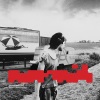
RETURN OF THE RANTERS
Sianne Don't Work In A FactoryUTR076 | CD / LP | 10 tracks, 50 minutes | Buy
During the brief English Commonwealth (1649-1660), a number of radical groups blossomed across the land; nonconformists, nudists, shakers, quakers, opponents of Church/State and of property ownership, free-thinkers, Diggers, Levellers and Ranters. In the equally austere years of the post-punk permafrost, and under the grip of another ruthless despot, freedom was in part personified by the widely vilified and brutally attacked people's Peace Convoy - a manifestation of idealism that was grotesquely smashed near Stonehenge on 1 June 1985; 537 arrested, children terrorised, idealism and hope stamped on with fear and violence. What was essentially a class war had been joined in the previous year with horse charges and gloved fists against miners and their families across Yorkshire. This was clearly intended to force home the point: "You are nothing. We own you and your labour. You work for us." It was during these dark times that Normil Hawaiians third album 'Return Of The Ranters' was written, recorded and shelved. Normil Hawaiians have always operated as a collective of musicians rather than a band per se and for this third album, the group comprised Guy Smith, Simon Marchant, Alun 'Wilf' Williams, Noel Blanden and Jimmy Miller. Recorded at Dave Anderson's Foel studio in Wales (sonic home of Amon Duul II and Hawkwind) in the Winter of 1985 - a time and a place triangulated from political, social and geographical aspects - 'Return Of The Ranters' extended their free experiments in compelling arrhythmia and seemingly organised sound, taking a loose trajectory from their previous albums and earlier, more confrontational approach. The album opens amidst vast clouds of atmosphere before the tape looped violin of "Sianne Don't Work In A Factory" starts to drag the song out of itself and into a sparse yet tender love song, full of hope, exalted synths and mechanised drum patterns. Acoustic guitars and walls of keyboard drone provide a fitting acre of space for the raw polemics of "Slums Still Stand", while "The Search For Um Gris" follows in full head-down, motorik mode with a miraculously hypnotic drum beat and whirling mood. "What's the colour of your heart?" sings Guy as the song spools out and grows onwards into the distance. "Battle Of Stonehenge" is a powerful and emotive recording detailing the band's personal experience of the aforementioned Police ransack of the Peace Convoy from the same year, and as a result provides the rallying point of album. Beginning bravely as a solitary spun-out voice, the song eventually becomes awash with choruses of guitar and reverberating synth, joined finally by adornments of violin and an entrancingly agile beat. "Mouldwarp's Journey" concludes the album with 10 minutes of epic improv, drawing on field recordings, murmured vocals, slowly-phasing tonal clusters, a miasma of percussion and wordless rapture. Lucid, candid, politically engaged, rarely metronomic but always humane, tired but still fighting, Normil Hawaiians' third album has waited patiently for thirty years. 'Return of The Ranters' was not released back in 1985 as with Guy, Jimmy and Wilf living in squatting communities in South London, and Simon and Noel re-locating their families to rural Kent, the Family Hawaii splintered and went its separate ways. In the intervening years, the band's reputation has grown considerably, far beyond the UK. Now the causes and conditions have finally come right, 'Return Of The Ranters' has finally been released. Come rejoice with us. All that falls, now falls into place... and all that was air now becomes solid. |
LINKS |
PRESS |
THE QUIETUSNTSNormil Hawaiians - radio special for NTS NARCFREQWIREMOJORECORD COLLECTORTHE QUIETUSLOUD AND QUIETLAST DAY DEAFAUSTIN TOWN HALLTHE QUIETUSFREQTHE QUIETUSRECORD COLLECTORALL MUSICWIREWIRELOUDER THAN WARGOD IS IN THE TVIMPOSEIF IT'S TOO LOUDCONE MAGAZINECAFE OTOALL MUSIC |
VIDEOS |
EXILESTHE OUTPOST (bonus track)THE BATTLE OF STONEHENGELIVE AT UPSET THE RHYTHMJOHN PEEL SESSIONSALLY IV |